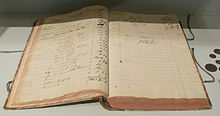
Bookkeeping is the recording of financial transactions, and is part of the process of accounting in business and other organizations. It involves preparing source documents for all transactions, operations, and other events of a business. Transactions include purchases, sales, receipts and payments by an individual person or an organization/corporation. There are several standard methods of bookkeeping, including the single-entry and double-entry bookkeeping systems. While these may be viewed as "real" bookkeeping, any process for recording financial transactions is a bookkeeping process.
Double-entry bookkeeping, also known as double-entry accounting, is a method of bookkeeping that relies on a two-sided accounting entry to maintain financial information. Every entry to an account requires a corresponding and opposite entry to a different account. The double-entry system has two equal and corresponding sides known as debit and credit. A transaction in double-entry bookkeeping always affects at least two accounts, always includes at least one debit and one credit, and always has total debits and total credits that are equal. The purpose of double-entry bookkeeping is to allow the detection of financial errors and fraud.

Debits and credits in double-entry bookkeeping are entries made in account ledgers to record changes in value resulting from business transactions. A debit entry in an account represents a transfer of value to that account, and a credit entry represents a transfer from the account. Each transaction transfers value from credited accounts to debited accounts. For example, a tenant who writes a rent cheque to a landlord would enter a credit for the bank account on which the cheque is drawn, and a debit in a rent expense account. Similarly, the landlord would enter a credit in the rent income account associated with the tenant and a debit for the bank account where the cheque is deposited.

Factoring is a financial transaction and a type of debtor finance in which a business sells its accounts receivable to a third party at a discount. A business will sometimes factor its receivable assets to meet its present and immediate cash needs. Forfaiting is a factoring arrangement used in international trade finance by exporters who wish to sell their receivables to a forfaiter. Factoring is commonly referred to as accounts receivable factoring, invoice factoring, and sometimes accounts receivable financing. Accounts receivable financing is a term more accurately used to describe a form of asset based lending against accounts receivable. The Commercial Finance Association is the leading trade association of the asset-based lending and factoring industries.

Accounts receivable, abbreviated as AR or A/R, are legally enforceable claims for payment held by a business for goods supplied or services rendered that customers have ordered but not paid for. The accounts receivable process involves customer onboarding, invoicing, collections, deductions, exception management, and finally, cash posting after the payment is collected. These are generally in the form of invoices raised by a business and delivered to the customer for payment within an agreed time frame. Accounts receivable is shown in a balance sheet as an asset. It is one of a series of accounting transactions dealing with the billing of a customer for goods and services that the customer has ordered. These may be distinguished from notes receivable, which are debts created through formal legal instruments called promissory notes.

Financial accounting is a branch of accounting concerned with the summary, analysis and reporting of financial transactions related to a business. This involves the preparation of financial statements available for public use. Stockholders, suppliers, banks, employees, government agencies, business owners, and other stakeholders are examples of people interested in receiving such information for decision making purposes.

A trial balance is a list of all the general ledger accounts contained in the ledger of a business. This list will contain the name of each nominal ledger account in the order of liquidity and the value of that nominal ledger balance. Each nominal ledger account will hold either a debit balance or a credit balance. The debit balance values will be listed in the debit column of the trial balance and the credit value balance will be listed in the credit column. The trading profit and loss statement and balance sheet and other financial reports can then be produced using the ledger accounts listed on the same balance.

In bookkeeping, a general ledger is a bookkeeping ledger in which accounting data are posted from journals and aggregated from subledgers, such as accounts payable, accounts receivable, cash management, fixed assets, purchasing and projects. A general ledger may be maintained on paper, on a computer, or in the cloud. A ledger account is created for each account in the chart of accounts for an organization and is classified into account categories, such as income, expense, assets, liabilities, and equity; the collection of all these accounts is known as the general ledger. The general ledger holds financial and non-financial data for an organization. Each account in the general ledger consists of one or more pages. An organization's statement of financial position and the income statement are both derived from income and expense account categories in the general ledger.

A general journal is a daybook or subsidiary journal in which transactions relating to adjustment entries, opening stock, depreciation, accounting errors etc. are recorded. The source documents for general journal entries may be journal vouchers, copies of management reports and invoices. Journals are prime entry books, and may also be referred to as books of original entry, from when transactions were written in a journal before they were manually posted to accounts in the general ledger or a subsidiary ledger.
The fundamental accounting equation, also called the balance sheet equation, is the foundation for the double-entry bookkeeping system and the cornerstone of the entire accounting science. Like any equation each side will always be equal. In the accounting equation every transaction will have a debit and credit entry, and the total debits will equal the total credits. It can be expressed as furthermore:
A bought ledger is a system in accounting by which a business records and monitors its creditors. The purchase ledger contains the individual accounts of suppliers from whom the business has made purchases on credit. Information on invoices and credit notes received, and payments made, are recorded in the supplier's account using the debits and credits system, with the balance of each account at a given moment representing the amount currently owed to that supplier.
Single-entry bookkeeping, also known as, single-entry accounting, is a method of bookkeeping that relies on a one-sided accounting entry to maintain financial information. The primary bookkeeping record in single-entry bookkeeping is the cash book, which is similar to a checking account register, except all entries are allocated among several categories of income and expense accounts. Separate account records are maintained for petty cash, accounts payable and receivable, and other relevant transactions such as inventory and travel expenses. To save time and avoid the errors of manual calculations, single-entry bookkeeping can be done today with do-it-yourself bookkeeping software.
A journal entry is the act of keeping or making records of any transactions either economic or non-economic.
In bookkeeping, accounting, and financial accounting, net sales are operating revenues earned by a company for selling its products or rendering its services. Also referred to as revenue, they are reported directly on the income statement as Sales or Net sales.
The following outline is provided as an overview of and topical guide to accounting:

Special journals are specialized lists of financial transaction records which accountants call journal entries. In contrast to a general journal, each special journal records transactions of a specific type, such as sales or purchases. For example, when a company purchases merchandise from a vendor, and then in turn sells the merchandise to a customer, the purchase is recorded in one journal and the sale is recorded in another.

A deposit account is a bank account maintained by a financial institution in which a customer can deposit and withdraw money. Deposit accounts can be savings accounts, current accounts or any of several other types of accounts explained below.
The history of accounting or accountancy can be traced to ancient civilizations.
A purchase returns journal is a prime entry book or a daybook which is used to record purchase returns. In other words, it is the journal which is used to record the goods which are returned to the suppliers. The source document which is used as an evidence in recording transactions into purchase returns journal is the Debit note.




